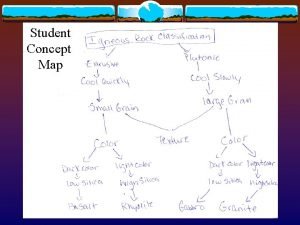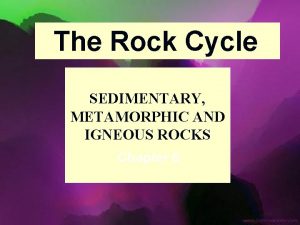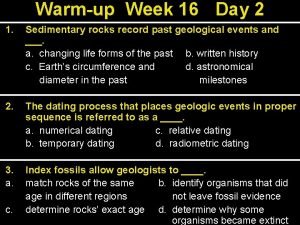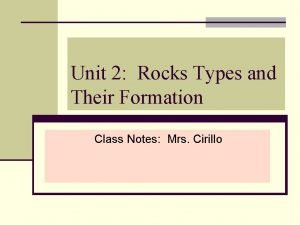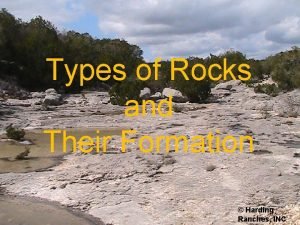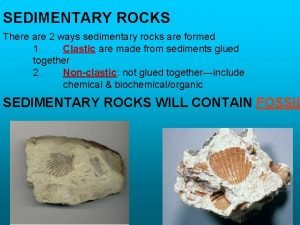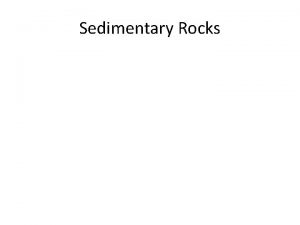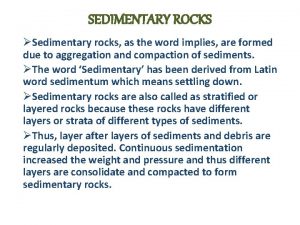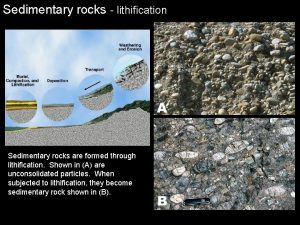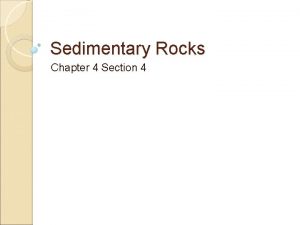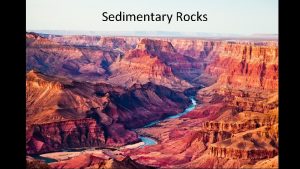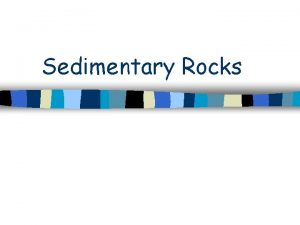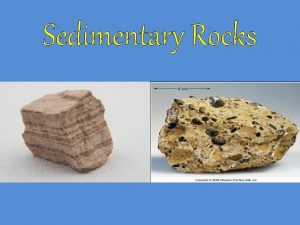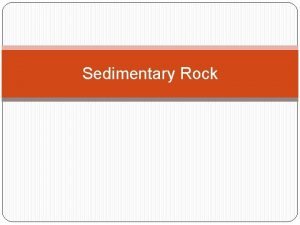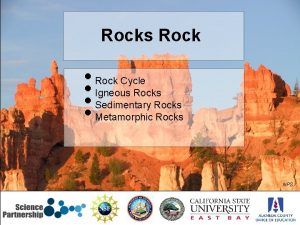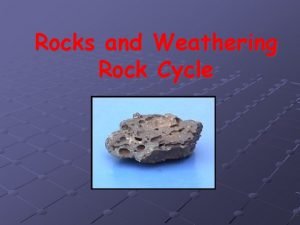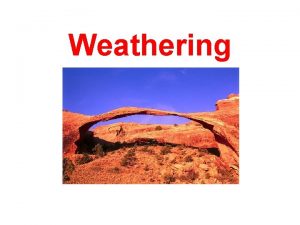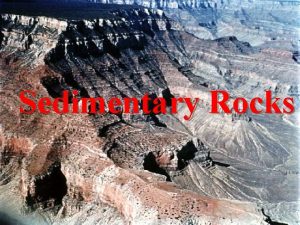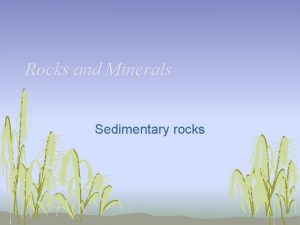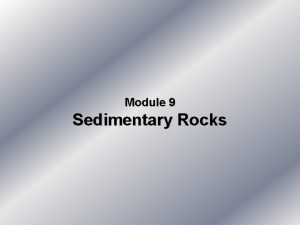Rocks and Weathering Rock Cycle sedimentary For thousands





















- Slides: 21

Rocks and Weathering Rock Cycle

sedimentary For thousands, even millions of years, little pieces of our earth have been eroded--broken down and worn away by wind and water. These little bits of our earth are washed downstream where they settle to the bottom of the rivers, lakes, and oceans. Layer after layer of eroded earth is deposited on top of each. These layers are pressed down more and more through time, until the bottom layers slowly turn into rock.

Sedimentary Conglomerate rocks are sedimentary rocks. They are made up of large sediments like sand pebbles. The sediment is so large that pressure alone cannot hold the rock together; it is also cemented together with dissolved minerals.

Sedimentary Gypsum rocks are sedimentary rocks made up of sulfate mineral and formed as the result of evaporating sea water in massive prehistoric basins. It is very soft and is used to make Plaster of Paris, casts, molds, and wallboards.

sedimentary Limestone rocks are sedimentary rocks that are made from the mineral calcite which came from the beds of evaporated seas and lakes and from sea animal shells. This rock is used in concrete and is an excellent building stone for humid regions.

Sedimentary Sandstone rocks are sedimentary rocks made from small grains of the minerals quartz and feldspar. They often form in layers as seen in this picture. They are often used as building stones.

Sedimentary Sandstone

Sedimenatry Shale rock is a type of sedimentary rock formed from clay that is compacted together by pressure. They are used to make bricks and other material that is fired in a kiln.

Utah sandstone

stalactite

Metamorphic rocks are rocks that have "morphed" into another kind of rock. These rocks were once igneous or sedimentary rocks. How do sedimentary and igneous rocks change? The rocks are under tons and tons of pressure, which fosters heat build up, and this causes them to change. If you exam metamorphic rock samples closely, you'll discover how flattened some of the grains in the rock are.

metamorphic Gneiss rocks are metamorphic. These rocks may have been granite, which is an igneous rock, but heat and pressure changed it. You can see how the mineral grains in the rock were flattened through tremendous heat and pressure and are arranged in alternating patterns.

Metamorphic schist Schist rocks are metamorphic. These rocks can be formed from basalt, an igneous rock; shale, a sedimentary rock; or slate, a metamorphic rock. Through tremendous heat and pressure, these rocks were transformed into this new kind of rock.

Schist garnet metamorphic

Igneous rocks are called fire rocks and are formed either underground or above ground. Underground, they are formed when the melted rock, called magma, deep within the earth becomes trapped in small pockets. As these pockets of magma cool slowly underground, the magma becomes igneous rocks. Igneous rocks are also formed when volcanoes erupt, causing the magma to rise above the earth's surface. When magma appears above the earth, it is called lava. Igneous rocks are formed as the lava cools above ground. Granite rocks are igneous rocks which were formed by slowly cooling pockets of magma that were trapped beneath the earth's surface. Granite is used for long lasting

Igneous Scoria rocks are igneous rocks which were formed when lava cooled quickly above ground. You can see where little pockets of air had been. Scoria is actually a kind of glass and not a mixture of minerals.

Igneous Basalt

Igneous granite Granite rocks are igneous rocks which were formed by slowly cooling pockets of magma that were trapped beneath the earth's surface. Granite is used for long lasting monuments and for trim and decoration on buildings.

Igneous obsidian Obsidian rocks are igneous rocks that form when lava cools quickly above ground. Obsidian is actually glass and not a mixture of minerals. The edges of this rock are very sharp.

Pumice rocks are igneous rocks which were formed when lava cooled quickly above ground. You can see where little pockets of air had been. This rock is so light, that many pumice rocks will actually float in water. Pumice is actually a kind of glass and not a mixture of minerals. Because this rock is so light, it is used quite often as a decorative landscape stone. Ground to a powder, it is used as an abrasive in polish compounds and in Lava© soap.

 Metamorphic rocks
Metamorphic rocks Compaction and cementation
Compaction and cementation The rock cucle
The rock cucle Concept map of sedimentary rocks
Concept map of sedimentary rocks Magma formation concept map
Magma formation concept map Rock cycle
Rock cycle Metamorphic sedimentary
Metamorphic sedimentary Sedimentary and metamorphic rocks section 6.1
Sedimentary and metamorphic rocks section 6.1 Clastic chemical and biochemical sedimentary rocks
Clastic chemical and biochemical sedimentary rocks Marble cleavage
Marble cleavage Sedimentary rocks record past geological events and ____.
Sedimentary rocks record past geological events and ____. Erosion sedimentary rocks
Erosion sedimentary rocks Esrt sedimentary rocks
Esrt sedimentary rocks Rock identification
Rock identification Organically formed sedimentary rocks
Organically formed sedimentary rocks 10 types of sedimentary rocks
10 types of sedimentary rocks Sedimentary
Sedimentary Characteristics of sedimentary rocks
Characteristics of sedimentary rocks What are sedimentary rocks
What are sedimentary rocks In sedimentary rocks lithification includes
In sedimentary rocks lithification includes How do sedimentary rocks form
How do sedimentary rocks form Sedimentary rocks
Sedimentary rocks



